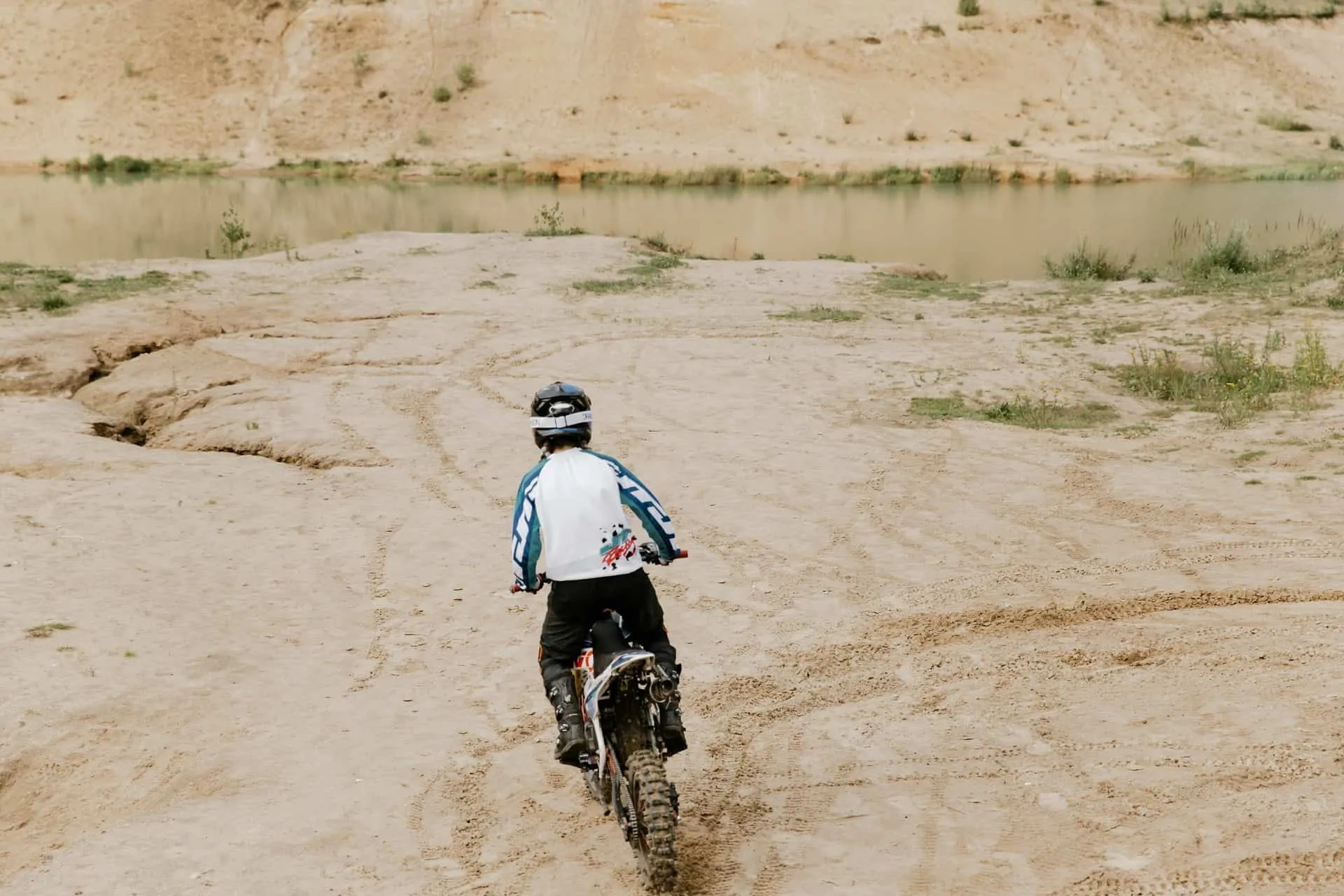Age sixteen is when your child might make the turn for more serious dirt biking. As he is nearing adulthood, it’s important to choose the correct transitional bike that’ll keep him safe while improving his dirt-biking skills.
When buying a dirt bike for your 16-year-old, make sure to:
- Find the correct dirt bike size, correct wheel size, and engine size
- Choose the correct engine type
- Consider the transmission and starter system
How To Buy A Dirt Bike For 16-Year-Olds
Find The Correct Dirt Bike Size
Not all 16-year-olds measure the same which means that there’s no fixed dirt bike recommendation that’ll apply for everyone. The best thing to do is to bring your teen to a dirt bike store and make him try a couple of options. If he is wearing sneakers, a third of his feet should be touching the ground. If he’s on the professional track and will be wearing motorcycle boots consistently, make sure to make him wear the motorcycle boots when trying out bikes. Both of his feet should comfortably touch the ground while the bike is upright which shows that he can balance himself when necessary.
There’s a chance that your teen might not find the perfect bike size for him. As a teen nearing adulthood, his height might be too much for smaller dirt bikes for kids. If this is the case, ask the motorcycle shop attendant for models with adjustable suspension. Adjust it in such a way that your child can comfortably grip the handlebars at a comfortable angle.
Correct Wheel Size
Most beginner dirt bikes below 125cc will either have big wheels (19/16”) or small wheels (17/14”). The former is more suitable for 16-year-olds. If his height and skill level can handle it, your teen can settle for a midsize to full-size bike with full-sized wheels. Bigger wheels are better because they are more stable and have better shock absorption, thus faring better over rough terrain.
Correct Engine Size
The bigger the engine, the more powerful the bike. Beginner riders often start with 50cc engines, but that might be too small for most 16-year-olds. Your child can start with a bike around 100cc to 125cc. If you think that’ll be too powerful, you can just purchase an aftermarket speed limiter that allows you to moderate the speed. This prevents over-speeding and you can just gradually increase it until your child is ready to ride at maximum speed.
If your child is already skilled enough, then you can give him a 250cc bike. This is usually suited for adults and skilled adolescents. To match the powerful engine, these bikes are usually of a full-size frame with full-size wheels.
The other signs that you should go for a bike upgrade are if your child is interested in motocross, if his knees get bent while riding which means he’s outgrowing his bike, and if he is ready to learn how to manually operate the clutch.
Engine Type: Two-Stroke Or Four-Stroke?
There are two main types of engines: two-stroke and four-stroke. Two-stroke bikes deliver power for every rotation of the crankshaft. As such, they provide more power than weight. This means that it has fewer moving parts that allow it to provide the same experience and power as larger engines. For example, a 2-stroke 65cc engine can be just as powerful as a 4-stroke 85cc engine. The only downside is that you need to pre-mix oil and petrol before pouring it in the gas tank to provide sufficient lubrication. This can be tiresome and maintenance can be annoying. Conversely, a 4-stroke engine may be easier to maintain but it produces less power. This can be perfect for beginner riders since the milder power is often deemed as manageable.
Transmission
An automatic transmission is more convenient for beginner riders. It allows them to shift between gears without thinking about it too much. A manual transmission means that the clutch needs to be manually operated just to perform shifting. While it provides better control for professionals, it can definitely be too much for beginners. It’s recommended to start with an automatic or semi-automatic transmission before graduating to manual bikes.
Starter System
There are two main starter systems for bikes: electric and kick start. Electric starter systems activate the whole bike with just a push of a button while kick start bikes need a lot of force and weight to start the bike. If your child is experienced enough and has the body frame for it, then he can go for a kick start bike. This is usually the norm for powerful bikes.
Should You Buy Brand New Or Used?
Brand new dirt bikes often cost a fortune. The ones with more expensive price tags have more features to justify it. There are pros and cons to buying a brand new bike. Your child may easily outgrow the one he has right now, which means that you’ll need to buy a new one in a year. One solution is to purchase a bike with an adjustable suspension so that you can just adjust the seat height to address any growth spurts. Buying new also means that the bike is less likely to have insidious issues, it will be covered by warranty, and might come with servicing to address any issues.
If your child is a beginner, then it makes sense to buy a secondhand starter bike with a smaller engine. This should be enough to teach him the basics before you invest in a bigger and more serious dirt bike.
Prepare The Riding Gear
Your child must wear protective riding gear so that he’ll stay cushioned in case of an accident. These protective gear are especially important if your child is a beginner. The protective gear includes:
- Helmet
- Boots
- Gloves
- Chest and back protection
- Neck brace
- Kidney belt
- Knee and elbow guards
- Jacket
- Motorcycle pants
- Goggles
Suzuki JR80
Braaap MX-110F
Honda CRF230F
Yamaha YZ125
